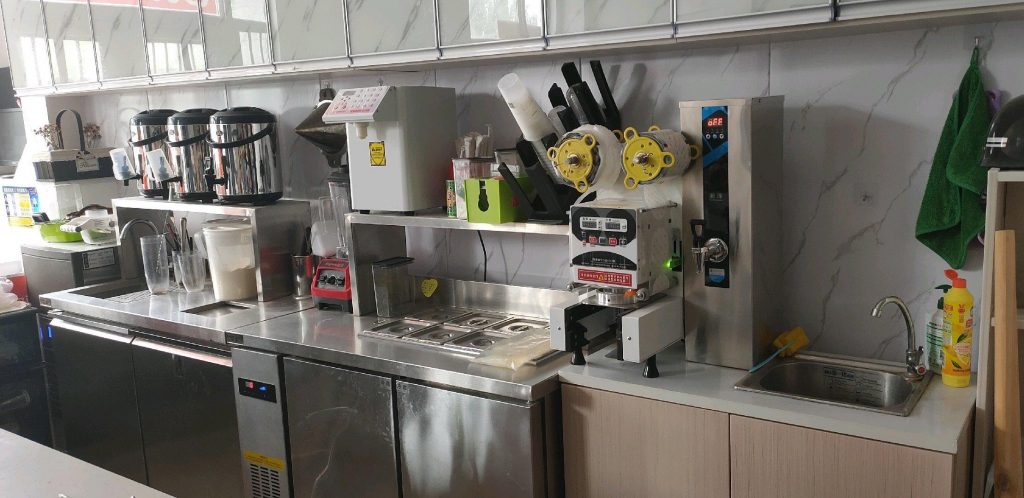
The post-pandemic beverage landscape has reshaped consumer expectations, prioritizing contactless service, speed, and health-conscious choices. For bubble tea businesses, adopting AI-driven equipment and automation technologies is no longer optional—it’s a strategic imperative. This article explores how artificial intelligence and smart automation are revolutionizing bubble tea production, reducing labor costs, and enhancing food safety, while addressing the industry’s evolving challenges.
—
Post-Pandemic Challenges in Bubble Tea Operations
The pandemic accelerated trends like remote ordering, hygiene-focused processes, and flexible business models. Key pain points for bubble tea shops include:
– Labor shortages: Reduced staff availability impacting peak-hour efficiency.
– Health regulations: Stricter sanitization requirements for shared equipment.
– Customization demands: Rising interest in allergen-free, low-sugar, and plant-based options.
AI-powered equipment addresses these challenges by streamlining workflows and adapting to new consumer behaviors.
—
AI-Driven Equipment: Key Innovations
1. Smart Order Prediction Systems
– Machine Learning Algorithms: Analyze historical sales data to predict popular drink orders, prepping ingredients in advance.
– Dynamic Menu Optimization: Automatically suggests menu adjustments based on real-time demand (e.g., promoting low-calorie options in health-focused markets).
2. Automated Beverage Assembly
– Robotic Arms: Precision-controlled arms for straining boba, steaming milk, and layering drinks with zero human intervention.
– Allergen Detection Sensors: Scan ingredients to flag cross-contamination risks, crucial for vegan or gluten-free customers.
3. Self-Cleaning Systems
– UV Sterilization: UV-C light disinfects contact surfaces between batches, reducing labor and compliance risks.
– Closed-Loop Water Recycling: Machines reuse water for cleaning, cutting utility costs by 40%.
—
Automation for Scalability and Cost Efficiency
Automation isn’t just for large franchises—it’s transforming small and medium-sized businesses too:
1. Cloud-Based Management Dashboards
– Remotely monitor equipment performance, track inventory, and schedule maintenance from a smartphone app.
2. Modular Robot Stations
– Plug-and-play modules for specific tasks (e.g., milk frothing, ice crushing), allowing businesses to scale automation incrementally.
3. Predictive Maintenance Alerts
– AI detects wear-and-tear patterns, scheduling repairs before breakdowns occur. This reduces downtime by 55% in pilot studies.
—
Health-Conscious Customization at Scale
Consumer demand for personalized beverages requires equipment that balances flexibility with efficiency:
– Adjustable Sweetness Pumps: Program precise syrup ratios for low-sugar or keto-friendly options.
– Plant-Based Milk Dispensers: Separate compartments for oat, almond, or soy milk, reducing cross-contamination risks.
– Temperature Control: Maintain tea concentrates at 85°C for optimal flavor while preventing bacterial growth.
—
Case Study: A U.S. Franchise’s Post-Pandemic Pivot
A mid-sized chain in California integrated AI equipment to survive labor shortages and shifting demand:
1. Robotic Baristas: Reduced staffing needs by 30%, with 95% order accuracy.
2. UV-C Cleaning Cycles: Cut sanitation time from 20 minutes to 5 minutes per shift.
3. Dynamic Pricing Algorithms: Increased profit margins by 18% through time-based promotions (e.g., 20% off iced drinks during peak heat).
—
Overcoming Adoption Barriers
Despite benefits, businesses hesitate due to upfront costs and technical complexity. Solutions include:
– Hybrid Models: Combine manual and automated stations to balance investment.
– Subscription Services: Pay-per-use AI software with free updates.
– Government Grants: Leverage incentives for foodservice tech adoption (e.g., USDA rural development funds).
—
The Future: AI-Powered Sustainability
Emerging trends to watch:
– Carbon Footprint Trackers: Machines calculate and offset energy/emission data per cup.
– Voice Commerce Integration: Voice-activated ordering for drive-thru or delivery apps.
– Blockchain Traceability: AI-linked systems verify sustainable sourcing of tea and tapioca pearls.
—
How to Prepare for an AI-Driven Future
1. Audit Existing Workflows: Identify repetitive tasks suited for automation.
2. Partner with R&D-Focused Manufacturers: Seek factories offering pilot programs for new tech.
3. Train Staff: Upskill employees to manage AI tools, ensuring job evolution rather than displacement.
—
Conclusion
AI and automation are redefining bubble tea equipment, turning pandemic challenges into opportunities for growth and innovation. By embracing smart technologies, businesses can future-proof operations, reduce costs, and deliver hyper-personalized experiences that resonate with modern consumers.
Ready to lead the AI revolution in bubble tea? Collaborate with manufacturers pioneering smarter, safer, and more sustainable equipment solutions.
Article link:https://www.vlefooena.com/manufacturer/3707/

No reply content